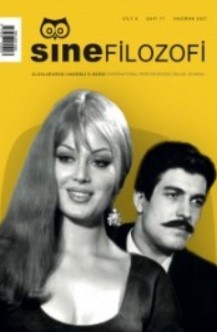Kraliçe Lear’in Élan Vital’ine Katılmak: Sinemada Bergson’un Yaşam Atılımı ve Sanatsal Yaratım Düşüncesi
Participating in Queen Lear’s Élan Vital: Bergson’s Thoughts on Vital Impetus and Artistic Creation in Connection with Cinema
Author(s): Tülay ÇelikSubject(s): Aesthetics, Contemporary Philosophy, Film / Cinema / Cinematography
Published by: Serdar Öztürk
Keywords: Élan vital; Vital impetus; Bergson; Queen Lear; Pelin Esmer; Artistic creation; Being; Evolution; Movement;
Summary/Abstract: This article attempts to grasp the relationship between the film Queen Lear and élan vital (vital impetus) drawing on the kinship of life as a creative evolution with art as a free act, which was established by Henri Bergson. According to Bergson, the élan vital, as the creative force of life, which is in a state of constant change and formation, is an invisible bond that passes through all living things. It is a free and creative flow. The qualities of élan vital, opening a door to aesthetic comprehension and helping us to gain a deeper understanding as to the relationship between artistic creation and life, trigger our conceptions about cinema. In this context, the film Queen Lear, which creates an aesthetic experience concerning the change and the transformation proceeded by élan vital, is discussed with the guidance of the intuition method and the cinephilosophical approach. Intuition is a method that offers a holistic insight that captures the unique and inexpressible within the subject; the cinephilosophical approach has also enabled the film to move forward and interact with it. Queen Lear makes the élan vital visible and palpable as the peasant women who do theater; as the director and the film. The film deals with the élan vital against the limits, inertia and habits imposed by social conditions, by focusing on the process, not the end, but the being, flow and change. The film joining the permanent flow between past, present and future, reveals the movement in duration. Making the transference movement of vital impetus between individuals and facts visible, turns the film into a transitional space. Images oscillating between women’s life, acting and the staging process of the play, higlights the production process of the film. At the same time they make the coexistence and relationality of life obvious. Consequently, as a living tissue that stimulates intuition, the film motivates to participate in the creative effort of the director. Bringing the audience closer to the direct vision of the reality, the film makes the audience feel the being and real movement in life.
Journal: SineFilozofi
- Issue Year: 6/2021
- Issue No: 11
- Page Range: 826-844
- Page Count: 19
- Language: Turkish

